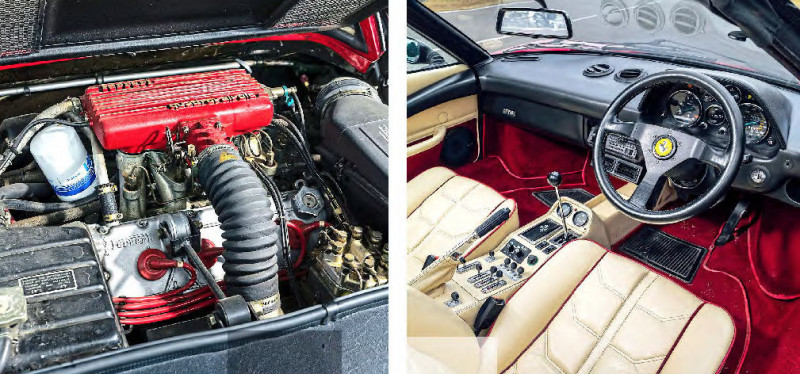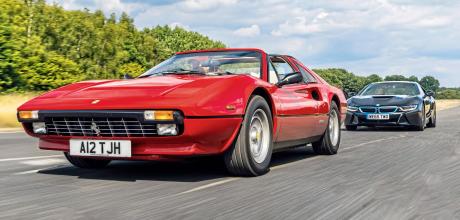1985 Ferrari 308GTSi
Enzo Ferrari famously stated – in the early years of his firm’s road car career – that his cars would be solely 12-cylinder powered. The practicalities of that decision probably didn’t sink in at first, but by the late Sixties, even he had to admit defeat, first introducing the V6-powered 206 and then the 246GT Dinos. Enzo was resolute, 12-cylinder power was for proper Ferraris, though public opinion proved to be stronger than the old man’s, and by 1976 the 308GT4 officially gained prancing horse badges – most dealers had already fitted them to Dinos anyway.
That 308 proved to be of relatively niche interest, but the next 308 was anything but. Swapping design studios from Bertone back to Pininfarina – and pensmiths from Marcello Gandini to Leonardo Fioravanti – proved to be a masterstroke (pun fully intended). The new 308GTB that emerged in 1975 – and the targa-top 308GTS that followed in 1977 – represented a welcome return to the organic, curving beauty of the Dinos.
Plenty of tactility to delight in here… Niki Lauda had a hand in refining the 308’s poise. Euro injection 308s weren’t stifled as much as US cars.

‘The BMW i8 is characterised by its ease of use, whereas this mid-engine classic plays hard to get’
Pre-1977, 308 bodies were made from glassfibre and together with the quad Weber caburetted 3.0-litre V8 engine from the previous 308GT4 2+2, the earliest, lightest and most powerful 308 could hit 60mph in 6.5 seconds and top 150mph. Later cars (post-1980) ditched the carburettors to get around US emission legislation, with Bosch K-Jetronic seeing a slight dip in horsepower and a big loss of sound and character. Close proximity to a 308 reminds you how small these junior supercars are. Everything was much smaller in the Seventies – sideburns aside – but even so, this Ferrari still seems compact. Its looks are impossible to ignore, every inch of bodywork sculpted to blend delicacy with a suggestion of aggression. The engine backs up the brawn, catching with an attention-stealing roar. With the gearbox proving forthcoming – they’re usually unenthusiastic when cold – exploring the entirety of its opengated dogleg pattern proves smirk-inducingly fun. Every interaction with this Ferrari carries such a mechanical heft that you have to work to get the best from it. By contrast, the i8 is characterised by its ease of use but this mid-engine Italian classic plays hard to get. Both occupy the same junior supercar territory but there’s a lot more that stands up to comparison. The Ferrari was styled in a traditional manner, the i8’s anything but, though both elicit plenty of attention. The BMW looks wild but is really a bit sedate in everyday use, while the Ferrari shouts about its sporting resolve from the ends of its chromed exhaust tips.
There are more gauges and readouts in the cabin than the nuclear facility’s control room, but the only one you need pay attention to is the big rev counter. This four-valve Quattrovalvole 308 spins around to 8000rpm with the redline around 7600 and the engine’s noise is its paramount characteristic – you can easily forgive its awkward cabin with the taps wide open. Performance was strong 30 years ago but it’s lost a lot of its shock and awe since then. It’s no slouch, but 60mph in just under seven seconds is nearly two seconds slower than the latest Golf GTI. On the other hand, the chassis’ grip and fine control still remains impressive. The roll is a little more pronounced than the i8’s, but because of this, it’s easier to gauge the Ferrari’s limits. The fast steering is riddled with feedback. Heavy turn-in, as the weight is transferred to the front end under braking, eases as you accelerate mid-corner – you’re constantly aware of which end has the grip. There’s a magnificent mechanical nature to driving this Ferrari quickly, which always requires an attuned driver.
Any old Ferrari can either be a joy or a disaster to own; the key is to seek out one that’s been cared for by an established specialist such as Slades Garage, where this 308 is currently for sale. These are some of the easiest Ferraris to work on, so there’s no excuse for any missed care. Old electrics can be problematic, as can hot starts on injected models. Check the front of the sills for corrosion, even on glassfibre cars (they’re still steel sills) and the belt line of steel cars. Trim doesn’t suffer wear well and is sometimes hard to source and expensive to rectify, so ensure what’s there is good. If it’s a GTS, make sure to smell for water ingress, given away by a mouldy scent. All 308s have commanded strong values for many years but there are a few that stand out for collectors. The rare (808 made) early ‘Vetroresina’ (glassfibre) cars carry a premium. Good, original and low-mileage examples with perfectly documented histories can demand £125k, though with so few made that could be seen as a bargain in the not-too-distant future. The most affordable way into 308 ownership is an early-Eighties GTBi or GTSi. They’re the least powerful, but still command £30k-£45k for one needing some work. The coupé GTB is generally worth a little less than the Targa GTS – blame a fictional mustachio’d Hawaiian TV detective for that. A £50k-£66k budget should get you a nice example of either.
Owning a Ferrari 308GTSi
Adrian Pearmund says, ‘I reckon the last QVs were always the cars to go for, having slightly more power and better protection against corrosion. I bought this car in early 2021 – it was certainly the best example I could find at the time – and it’s been an absolute joy to live with ever since. The only items that needed replacing were the gas struts that hold up the engine cover, plus the clock and door rubbers. Maranello Classic Parts is well stocked, so I’ve had no problems finding original parts. Ownership costs are very reasonable, on the condition that the car is well looked after. Annual services, with belt changes every couple of years, is very manageable and costs even less than some non-exotic cars I’ve owned. The team at Slades Garage does a sterling job of keeping it in great condition.’
TECHNICAL DATA 1985 Ferrari 308GTSi
- Engine 2926cc, 32-valve V8, dohc, Bosch K-Jetronic fuel injection mated to Marelli MED 803A Digiplex electronic ignition (coil, distributor and ignition module per bank)
- Power and torque 237bhp @ 7000rpm; 191lb ft @ 5000rpm
- Steering Rack and pinion
- Transmission Five-speed manual, rear-wheel drive
- Suspension Front: double wishbones, coil springs, telescopic dampers, anti-roll bar. Rear: double wishbones, coil springs, telescopic dampers, anti-roll bar
- Brakes Servo vented discs all round
- Performance Top speed: 158mph;
- 0-60mph: 6.7sec
- Weight 1286kg (2835lb) dry weight
- Fuel consumption 22mpg
- Cost new c. £30,000 (price in 1975)
- Classic Cars Price Guide £30k-£55k (GTBi/Si)


